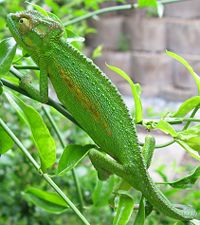Sandbox chameleon
From Proteopedia
(Difference between revisions)
| (42 intermediate revisions not shown.) | |||
| Line 1: | Line 1: | ||
| - | == | + | ==Does the amino acid sequence ''really'' determine the 3D structure of a peptide?')== |
| - | + | ||
| - | + | ||
| - | + | ||
| - | == Function == | ||
| - | Display this IgG-Binding domain in <scene name='61/611439/Rainbow_cartoon/1'>Rainbow Ribbon</scene> | ||
| - | ''i.e.'' going from Blue---Red from N--->C terminal. Simply things with all coloured in <scene name='61/611439/Cartoon_beige/1'>beige</scene> | ||
| - | Now display the structure mutated structure where 5 amino acids, in this region <scene name='61/611439/Cartoon_pink_23-33/1'>23-33</scene>, were change to the Chameleon sequence, i.e. '''AWTVEKAFKTF''' | ||
| - | i.e. going from: | ||
| - | TTYKLILNGKTLKGETTTEAVDAATAEKVFKQYANDNGVDGEWTYDDATKTFTVTEK | ||
| - | TTYKLILNGKTLKGETTTEAVD'''AWTVEKAFKTF'''ANDNGVDGEWTYDDATKTFTVTEK | ||
| + | <StructureSection load='2gb1' size='350' side='right' caption='2gb1' scene='61/611439/Rainbow_cartoon/1'> | ||
| + | [[Image:Chameleon.jpg|left|200px|thumb|Chamelion]] | ||
| + | ==General question== | ||
| + | To determine the extent to which '''non-local''' factors influence the formation of secondary structural elements | ||
| + | ==Methodology== | ||
| + | Design the longest possible sequence that can fold into an alpha-helix when inserted into one place in a protein sequence and a beta-sheet when inserted into another. Two key references are: on a ''Chameleon'' peptide<ref>PMID:8614471</ref> and an analysis of Helix-to-Strand Transition Between Peptides with Identical Sequences<ref>PMID:10966577 </ref>. | ||
| + | == Seeing is believing == | ||
| + | To simplify the figure, the entire IgG-Binding domain<ref>PMID:1871600 </ref> is colored <scene name='61/611439/Cartoon_beige/3'>beige</scene>. Now displaying, in pink, the amino acids in the region <scene name='61/611439/Cartoon_pink_23-33/1'>23-33</scene>, are change to the ''Chameleon'' sequence, i.e. '''AWTVEKAFKTF''' (only 5 amino acids are mutated), specifically from/to:<br /> | ||
| + | TTYKLILNGKTLKGETTTEAVDAATAEKVFKQYANDNGVDGEWTYDDATKTFTVTEK<br /> | ||
| + | TTYKLILNGKTLKGETTTEAVD'''AWTVEKAFKTF'''ANDNGVDGEWTYDDATKTFTVTEK | ||
| - | + | If a similar change from the Wild-Type to where 5 amino acids, in the region <scene name='61/611439/Cartoon_pink_42-52/1'>42-52</scene> are changed to the ''Chameleon'' sequence, specifically from/to:<br /> | |
| - | <scene name='61/611439/ | + | TTYKLILNGKTLKGETTTEAVDAATAEKVFKQYANDNGVDGEWTYDDATKTFTVTEK<br /> |
| + | TTYKLILNGKTLKGETTTEAVDAATAEKVFKQYANDNGVDG'''AWTVEKAFKTF'''TVTEK | ||
| - | + | = The 3D structure of the ''Chameleon'' sequence, '''AWTVEKAFKTF''', appears to adopt to its environment. = | |
| - | + | ||
</StructureSection> | </StructureSection> | ||
== References == | == References == | ||
<references/> | <references/> | ||
Current revision
Does the amino acid sequence really determine the 3D structure of a peptide?')
| |||||||||||
References
- ↑ Minor DL Jr, Kim PS. Context-dependent secondary structure formation of a designed protein sequence. Nature. 1996 Apr 25;380(6576):730-4. PMID:8614471 doi:http://dx.doi.org/10.1038/380730a0
- ↑ Zhou X, Alber F, Folkers G, Gonnet GH, Chelvanayagam G. An analysis of the helix-to-strand transition between peptides with identical sequence. Proteins. 2000 Nov 1;41(2):248-56. PMID:10966577
- ↑ Gronenborn AM, Filpula DR, Essig NZ, Achari A, Whitlow M, Wingfield PT, Clore GM. A novel, highly stable fold of the immunoglobulin binding domain of streptococcal protein G. Science. 1991 Aug 9;253(5020):657-61. PMID:1871600

